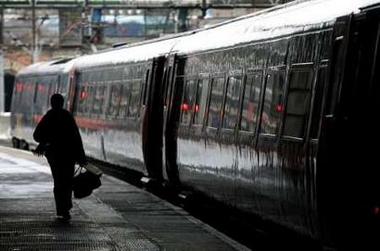U.S. Federal Rail Policy: Learning from Worse Practices
 A commuter walks to board a train at Kings Cross station in central London January 2, 2006. British rail passengers face higher ticket prices on Monday as above inflation increases announced last month come into effect. REUTERS/Paul Hackett
A commuter walks to board a train at Kings Cross station in central London January 2, 2006. British rail passengers face higher ticket prices on Monday as above inflation increases announced last month come into effect. REUTERS/Paul Hackett Today's Telegraph has three stories related to significant price increases in British railroad transportation, including the introduction of a new pricing system for London Transport that gives smart card users huge discounts compared to traditional fare purchasers such as tourists.
(See the stories: 2006 Will be the year of rising prices; Leader: No fare deal for rail commutersTrains more crowded as demand grows; and Trains more crowded as demand grows, as well as this story from the Guardian, "Passenger groups condemn rail fare rises.")
U.S. government officials frequently use the British example of privitization, yet the British railroad system is expensive and is widely criticized for operational failures, especially compared to the state-of-the-art rail systems in continental Europe.
British fares are expensive compared to both the Amtrak Northeast Corridor service and to France. To get to Manchester England from London and back, a distance of 181 miles each way, costs about £202, which is $347! (This doesn't take into account any discounts, monthly passes, etc.) The cost for Amtrak round trip service to New York from Washington is about $170; this distance is 220 miles and the trip takes between 3 and 4 hours.
However, the cost to get from Paris to Nantes is €102 ($120) for second class service without advanced ticket purchase. It costs only €60 to €70 ($71-$83) with a two-week advanced purchase.
More importantly, because French rail is replete with high-speed trains due to their continued investment in advanced technology, this trip of 212 miles one-way takes about 2 hours, which is 1/2 the time of driving, and only a little longer than taking a plane. Talk about encouraging rail transit...
As discussed in a review of the book British Rail, 1974-97: from Integration to Privatisation:
By the early 1990s the new BR management structure converted large deficits in Intercity and Network Southeast passenger services into significant profits which grew even through a recession, while most passenger traffic was retained. While initiatives in freight generally failed, the Tory government's confidence in British Rail management soared, prompting it to approve major new rail investments, including electrification of the east-coast main line and construction of the Channel tunnel.
The successful evolution of sector management in the early 1990s into what the board called Organisation for Quality resulted in vertically integrated sectors that could have been privatised, with the board remaining as a government-backed policy-making body that also would maintain a culture of safety. The board favoured this approach. Almost without warning, however, the Tory government in 1993 backed a privatisation plan put forward by free-market ideologues based on separating infrastructure, train operation, and maintenance functions.
Gourvish is unequivocal in his assessment that the break-up of the vertically integrated sectors was a mistake. Assets were sold at below market value, there were large costs of privatisation, the culture of safety was lost, profits disappeared, management attention was diverted from train operation to the selling of assets, resulting in service deterioration, and, most important, there was no organisation remaining that had a long-term vision for making railway investments. Far from improving the public welfare, privatisation diminished it. (From the Journal of Transport History, March 2004, review by Gregory Thompson of book by Terry Gourvish.)
Or, as the Talking Cities website says:
As the rail industry has long been blighted by under investment, the UK's train network is poor in comparison to the sleek and efficient rail services in much of Western Europe. The hope was that private sector discipline and investment would transform the situation for long suffering commuters, but so far, many of the expected improvements have failed to materialize. However, there is currently a major infrastructure upgrade taking place and modern new trains are at last beginning to appear. The Government has also begun a massive injection of public investment into improving current services, also adding new lines and stations. Of course, the Tube system is different story altogether though...
I was talking with a friend-colleague today about open-eyed analysis rather than political correctness. I joke that my core competency of "brutal honesty" gets in the way of good employment sometimes. But if you aren't clear-eyed about what you're dealing with, you're likely to fail. Policy making with blinders doesn't usually move things forward in a way that helps... (Ask the Iraqis...) Failure is costly.
Index Keywords: railroads



0 Comments:
Post a Comment
<< Home